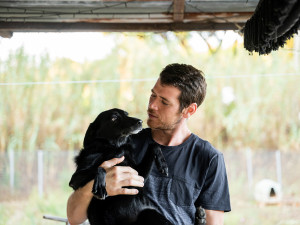Dog Speak: The Sounds of Dogs
Decoding the many sounds your pup makes.

Share Article
If there’s one universal truth for all dog moms and dads, it’s that we’re all convinced our pups are talking to us. The sigh that means, “Stop posting pics of me on Instagram and take me for a walk!” The grumble that means, “It’s only 4:30p.m. but I’m ready for dinner, human!”
Vocalizations provide us with a window into dogs’ everyday experiences. Social species are known to be much noisier than animals who lead solitary lives. So given that dogs (and their wild progenitor, the wolf), are super social, it’s no surprise that they produce a wide range of vocalizations: they barkopens in a new tab, whine, whimperopens in a new tab, howl, huff, growl, yelp, and yip (among other nuanced sounds). From the earliest moments of their lives, dogs produce tonal yelps and whines, and atonal barks and grunts appear in the first few weeks of life in conjunction with the onset of social behavior.

littleKin™ is Kinship’s home just for puppy and kitten parents. Bop over to check out expert advice, new pet tools, and special deals—all curated for your newest family member.
opens in a new tabThere’s a big difference between the bark of an adult dog and that of an adult wolf, however. Dogs seem to play every instrument in the orchestra, hitting the highs of Mariah Carey in the ’90s and the lows of a commercial narrated by Morgan Freeman. Plus, there seems to be no context in which a dog won’t bark: They bark when alone and with other dogs. Some bark before, during, and even after a ball is thrown. A car goes by or the doorbell rings and barking ensues. In contrast, wolves bark less frequently and in fewer contexts, primarily for warning or defense.
What Do Barks Mean?
So what do all of those yelps and gruntsopens in a new tab and yips really mean? Animal behavior researchers have only recently begun to answer this question. “Vocal behavior in other species has received a lot of detailed attention,” says Monique Udell, PhD, and the Director of the Human-Animal Interaction Laboratory at the University of Oregon. “In birds, we’ve looked down to the note sequence and explored tiny variations. Vocalizations are such a prominent feature of dogs, and there is a lot to learn.” To date, dog vocalizations have not received comparable scrutiny.
Growls
That being said, research that has been conducted on the subject is incredibly insightful. Take growls, which, it has been shown, dogs use to accurately judge another dog’s size. How in the world do we know that? Tamás Faragó, PhD, and his colleagues at the Family Dog Projectopens in a new tab at Eötvös Loránd University in Budapest presented dogs with two images of the same dog: one was true to size and another was 30% larger or smaller. Dogs then listened to a pre-recorded growl, and most dogs looked at the image of the full-size dog rather than the altered image.
Growlsopens in a new tab appear to be meaningful in other ways as well. In another study, Dr. Faragó and his colleagues used some clever trickery to explore how dogs respond to growls recorded in different situations. In an apparently empty room, a dog was allowed to approach a bone. Unbeknownst to the dog, there was a speaker hidden behind the bone, and as the dog approached, the sound of a “play growl,” a “stranger-approaching” growl, or a “food-guarding” growl was transmitted through it. Dogs were likely to take the bone when hearing the “stranger-approaching” or “play” growl, but the food-guardingopens in a new tab “my bone” growl deterred them. Even though the food-guarding and stranger-approaching growls sound quite similar (at least, to our ears), they prompted different behavior.
Many studies investigating vocalizations are based on pre-recorded samples, but it is important to remember that vocalizations and visual signals usually go hand-in-hand. In the stranger approaching context, dogs growled with closed mouths, whereas in food defense situations, they showed their teeth and pulled back their lips.
Barks
While we tend to take notice when we hear a growl, we often dismiss barking as meaningless noise, as though it is simply an item on a dog’s daily checklist: Take a walk, have breakfast, bark. Before the turn of the century, that was the prevailing view among researchers and theorists. At most, barking was thought to result from social facilitation — one dog barking prompts other dogs to bark — or maybe attention seeking, or even rivalry or defense.
Only recently have researchers begun to investigate whether barks produced in different contexts vary in their acoustic parameters (such as tone and pitch). Scientists theorized that if — like growls — barks displayed consistent differences, they might have a more specific communicative function, perhaps even be associated with a dog’s internal motivational or emotional state. For example, some barks might convey aggressionopens in a new tab while others might convey friendliness.
In one early study Dr. Sophia Yin, DVM, MS, recorded a variety of breeds barking in response to different situations: a stranger ringing the doorbell (“disturbance barks”), separated from an owner (“isolation barks”) and play. Dr. Yin found that the barks did indeed have different acoustic properties. Disturbance barks were harsher and lower in pitch with little amplitude modulation, while isolation and play barks were pitched higher and had greater tonal and higher frequency and a wider range of amplitude modulation. More recent studies confirm that dog barks follow particular patterns. For example, a dog barking at a stranger sounds very different from a dog barking before going on a walk.
But do these vocalizations carry meaning? They do for dogs. When dogs in one study listened to barks recorded in a new context or from a new dog, they gave more attention to the unfamiliar bark. This suggests that dogs can detect that some barks are different from others, though scientists are still exploring ways to determine how exactly they perceive and process that information.
Humans, too, can decipher barks. Whether or not they’re experienced with dogs, people are quite good at classifying barks into their appropriate contexts and attributing them to perceived emotional states. After listening to randomly played recordings, people describe isolation barks as full of despair, while barks from a play session are said to be happy. (So you’re probably spot-on that your neighbor’s Dalmatian who yaps all day is lonely.) Our ability to do this starts early; by age 10, children are able to assign different-sounding barks to the correct context. Today, we can distinguish the acoustic properties of certain barks so accurately that we’re able to program computers to categorize them.
Recognizing The Audible Patterns
Apparently, when it comes to chatting, dogs and humans have more in common than grumbling when it’s dinnertime. Through their shared mammalian histories, canine and human vocalizations follow similar acoustic patterns. High-pitched and more tonal noises convey friendliness, affiliation, and “come here,” whereas low-pitched and less tonal sounds convey aggression and “go away.” These rules and tendencies, which are found across mammalian and avian species, govern our own communication and emotional expression.
Internal Motivational State of Conflict
A recent publication by Kathryn Lord, PhD, offers an additional take on why dogs bark. She and colleague Ray Coppinger, PhD, investigated the contexts in which other species use bark like sounds: “When other species emit their version of a bark, they are usually in some sort of conflicting situation. For example, an animal is at a nest or den and observes some sort of threat. Customarily, the animal would run, but because of their situation, they can’t, so they bark,” she explains. “We think [that] when dogs bark, they are making these sounds in association with an alert or an internal motivational state of conflict.”
More Domesticated Situations = More Barks
In a sense, Dr. Lord and Dr. Coppinger argue that “conflicted” should be dogs’ middle name. They suggest that dogs bark in so many different situations because they often find themselves conflicted: they are in the house and want to go out, they are out and want to come in. And it may be that, through the process of domestication itself, dogs have become more prone to put themselves in these sorts of situations. In comparison with wolves, dogs have a substantially decreased flight distance; something can easily get too close before the dog feels conflicted about how to respond.
Dr. Udell suggests that barking doesn’t have to be whittled down to one simple explanation. “If you look at communication and vocalizations in a wide range of species, it usually isn’t about one thing,” he asserts. “Chickadees have ‘alert’ calls, but they also have songs, and the songs themselves can mean different things in different contexts. I think the same could hold true for dogs.”
Other Reasons for Non-Stop Barking
These general insights are just part of the story. Genes and environment affect all things dog, including vocalizations. In their seminal study of dog behavior and genetics, John Paul Scott and John Fuller note that when Basenjis, a typically “barkless” dog, do actually bark, they generally produce only one or two low “woofs.” On the other hand, “the maximum number of barks recorded for a Cocker Spaniel in a 10-minute period was 907, or more than 90 a minute.” Why the Guinness Book of World Records was not contacted is beyond us.
But genes aren’t everything. As Susan Friedman, PhD, a pioneer in the application of applied behavior analysis to captive and companion animals and a psychology professor at Utah State University, explains, “While Shih Tzus as a group tend to display less barking than Miniature Poodles, that doesn’t mean barking in Miniature Poodles is impervious to change,” she says. “And I’ve certainly known individual Miniature Poodles who are quiet and individual Shih Tzus who are barky, both based on their current situations. The individual always bests any generalization.”
Dr. Yin’s study about dog barks supports this theory. Even within breeds, she found variations in who barked and when. Rudy and Siggy, 11-year-old German Shorthaired Pointers, both barked in the disturbance context, but when alone, Rudy did not bark and Siggy had lots to say.
And then there are the effects of a pup’s social environment on their behavior: For example, feral dogs are much less noisy than their counterparts who play with toys, sleep in beds and go to obedience class. Dr. Friedman explains. “For dogs, barking is a functional behavior, meaning it is maintained, increased or decreased due to consequences. Once this is [understood], it opens the door to changing the duration, intensity and frequency of the behavior by changing the consequences.” In other words, dogs can learn to be quieter.
However, perfect quiet is probably unrealistic. Pet parents can’t always control the stimuli that prompt barking, especially if they’re not home 24/7. Moreover, barking that has been solidified and maintained over time through intermittent reinforcement has a lot of staying power. “It seems that owners unintentionally reinforce the barks produced when a dog is around food or toys, and these become the begging barksopens in a new tab of that dog,” says Faragó. Laura Monaco Torelli, CPDT-KA CTP, director of training at Animal Behavior Training Concepts in Chicago, agrees. “If a dog learns that the noise in the hallway goes away when he barks, barking becomes an effective behavior. Barking is followed by the consequence of the noise in the hallway stopping.”
Strategies For Change
So what can dog moms and dads do about barking? Before you get carried away, consider whether or not action is even required. Dr. Friedman advises taking a step back. “When we ask, ‘Is barking a behavior problem?’ the [next] question is, ‘For whom?’ Barking certainly is a problem when people say it is, and for dogs, it is a problem when they are spending so much time doing it that it eclipses other healthful activities.”
Pet parents should focus not on eliminating barkingopens in a new tab altogether, but on reducing it to levels they find appropriate and livable. When she meets with clients to discuss their dogs’ barking issues, Monaco Torelli asks questions such as, “How many barks is okay? What’s excessive to you?” This, she says, gives the trainer a good starting point from which to develop a plan to teach the client how to reshape a dog’s barking behavior. Trainers and pet parents discuss acceptable barking, and then implement techniques to achieve desired levels in each context.
Dr. Friedman shares the way she manages her own dog’s barking: “We live in the country, and when we let the dogs out, they bark at the deer for a number of seconds. Then we say, ‘That’s enough, thank you,’ and they are quiet and we praise them.” She adds, “It’s a [mistake] to think that barking is the problem. The real problem is that dogs don’t stop barking when we ask.”
So-called “quick fixes” can make barking worse, particularly if the underlying reason for the behavior isn’t addressed. “Putting an anti-bark collar on a fearful dog is unlikely to decrease barking if the consequence [shock or spray] increases the dog’s fear. If the fear increases, barking could as well,” explains Maryland-based Mary Huntsberry, MA, ACAAB. It helps to start early and be observant. Teaching dogs the boundaries opens in a new tabof acceptable vocalizations from an early age will pay off for everyone; when pups are young, barking might be cute, but as they age, the cute factor tends to wear off. If the behavior is already in place, there are ways to alter it, Huntsberry observes. “It helps to do a functional analysis. During an extensive interview, I identify what happens immediately before (antecedent) and after (consequence) the unwanted behavior so I can identify the trigger and what maintains it.”
Monaco Torelli focuses her attention on the dog-human relationship. “When owners are frustrated by their dog’s behavior, we show them some immediate training goals and success points so they see that their dog can do what they want them to be doing, instead of what they don’t want them to do,” she says. This helps them rebuild their bond with their dog. The takeaway message is that barking is a nuanced and flexible behavior, and relationships can grow by paying attention to what your dog’s vocalizations mean. Maybe all that whining for a walk means your pup knows you both need to step away from social media for a second and get outside.

Julie Hecht, MSc
Julie Hecht, MSc, is a PhD candidate studying animal behavior at the Graduate Center, CUNY, and author of the Dog Spies blog at Scientific American. She would really like to meet your dog.
Related articles
![Dog barking]() opens in a new tab
opens in a new tabHow to Stop Your Dog From Barking
The top five reasons dogs bark—and how to get them to relax a bit.
![Mixed dog laying on the floor int he sun with an unsure look on her face]() opens in a new tab
opens in a new tabDecoding Your Dog’s Growls
When your dog growls, they’re expressing their emotions. A study found that you’ll likely be able to understand what they’re feeling.
![A man holding a dog with an unsure look on its face.]() opens in a new tab
opens in a new tab“Why Does My Dog Bark at Men?”
What to do when your dog barks at the men in your life.
- opens in a new tab
We Answer the Age-Old Question: Why Do Dogs Howl?
How to help a howling dog turn down the volume (or even hit the off button).





